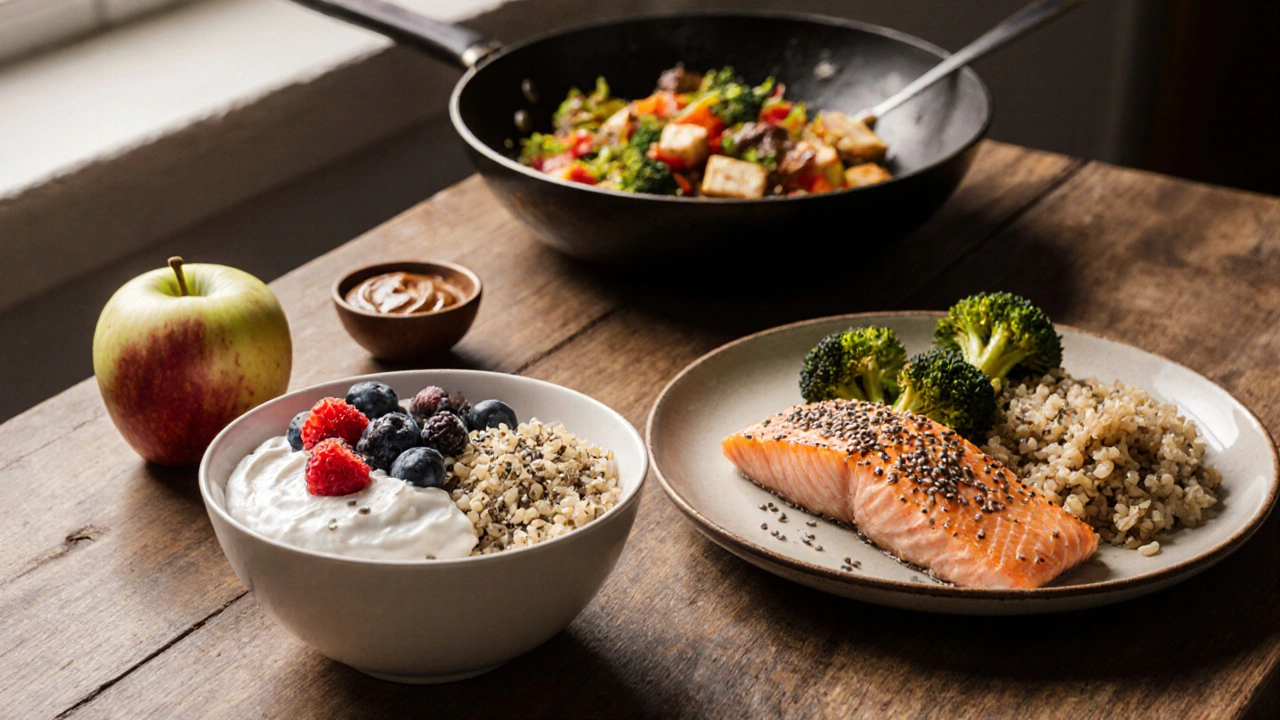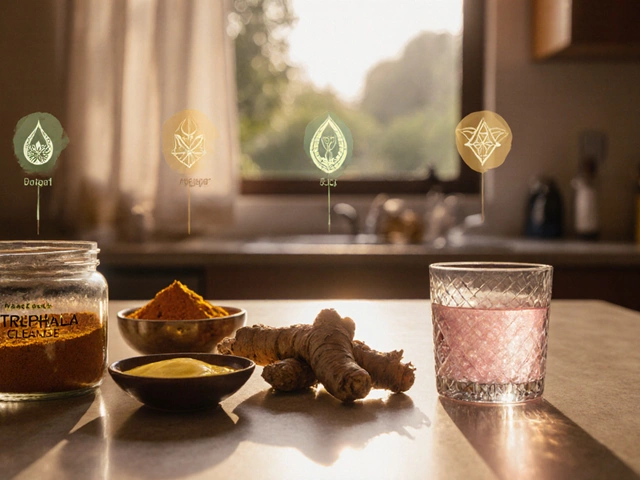Calorie Needs Calculator for a 55-Year-Old Woman
Enter Your Details
This calculator estimates your daily calorie needs to support healthy weight loss. Enter your information below:
Your Personalized Calorie Needs
Based on your inputs, here’s your estimated daily calorie intake for healthy weight loss:
Basal Metabolic Rate (BMR): kcal/day
Total Daily Energy Expenditure (TDEE): kcal/day
Recommended Calorie Intake for Weight Loss: kcal/day
Macronutrient Breakdown:
- Protein: g (% of total calories)
- Fat: g (% of total calories)
- Carbs: g (% of total calories)
Finding the right calorie intake for a 55‑year‑old woman can feel like cracking a code. The good news is you don’t need a PhD in nutrition-just a clear roadmap that blends science with everyday life. Below you’ll see how to figure out your personal numbers, adjust them for activity and menopause, and turn those calories into steady, safe weight loss.
What is Basal Metabolic Rate (BMR) and why it matters
Basal Metabolic Rate is the amount of energy your body uses at complete rest, just to keep the heart beating, lungs breathing, and cells functioning. For a 55‑year‑old woman, BMR is typically lower than in younger years because muscle mass naturally declines and hormonal shifts slow metabolism. The most reliable quick estimate uses the Mifflin‑St Jeor equation:
BMR = (10 × weight in kg) + (6.25 × height in cm) - (5 × age) - 161
Example: 68kg, 162cm tall, 55 years old → BMR ≈ 1,300kcal/day. This is the baseline you can’t go below without risking muscle loss or fatigue.
Adding Activity Level: Total Daily Energy Expenditure (TDEE)
Total Daily Energy Expenditure (TDEE) combines BMR with the calories burned through daily movement and exercise. Multiply your BMR by an activity factor:
- Sedentary (little or no exercise): BMR × 1.2
- Lightly active (light walking, yoga 1‑3days/week): BMR × 1.375
- Moderately active (brisk walking, cycling 3‑5days/week): BMR × 1.55
- Very active (intense cardio, strength training 6‑7days/week): BMR × 1.725
Using the 1,300kcal BMR example, a moderately active lifestyle yields a TDEE of about 2,015kcal/day.
Menopause, Hormones, and Their Effect on Calories
Menopause typically occurs between ages 45‑55 and brings a drop in estrogen. That shift can add 5‑10% more fat storage and slightly reduce resting metabolic rate. The practical tip? Add a modest 100-150kcal buffer to your TDEE calculation if you notice a slower weight loss despite following the numbers.

Creating a Calorie Deficit the Safe Way
Calorie deficit is simply eating fewer calories than your TDEE. The classic recommendation is a 500kcal/day deficit, which translates to roughly 0.45kg (1lb) of weight loss per week. For a woman with a TDEE of 2,000kcal, the target intake would be about 1,500kcal.
Why not go lower? Dropping below 1,200kcal for most women can trigger nutrient gaps, hormone disruption, and loss of lean muscle. Keep the deficit moderate, and let exercise pick up the extra burn.
Dividing Your Calories into Macronutrients
Macronutrients (protein, carbs, fats) dictate how your body uses those calories. A balanced split for weight loss in mid‑life looks like:
- Protein: 25‑30% of total calories (helps preserve muscle). For 1,500kcal → 94‑113g.
- Fats: 25‑30% (supports hormone health). → 42‑53g.
- Carbohydrates: 40‑50% (provides energy). → 150‑188g.
Prioritize lean meats, fish, legumes, whole grains, nuts, and plenty of non‑starchy vegetables.
Sample Meal Plan: 1,500kcal for a 55‑Year‑Old Woman
These numbers are real‑world, not a diet fad. Adjust portions based on your own TDEE and activity level.
| Meal | Food | Portion | Calories |
|---|---|---|---|
| Breakfast | Greek yogurt + mixed berries + 1 tbsp chia seeds | 200g + ½ cup + 1 tbsp | 250 |
| Snack | Almonds | 15g (≈12 pieces) | 90 |
| Lunch | Grilled salmon, quinoa, roasted broccoli | 120g + ½ cup + 1 cup | 420 |
| Afternoon snack | Apple + 1 tbsp peanut butter | 1 medium + 1 tbsp | 180 |
| Dinner | Stir‑fried tofu, mixed veggies, brown rice | 150g + 2 cups + ½ cup | 560 |
Notice the steady protein at each meal, healthy fats, and fiber‑rich carbs that keep blood sugar stable.

Common Pitfalls and How to Avoid Them
- Skipping meals can sabotage metabolism. Aim for three balanced meals plus a snack.
- Relying on “diet” foods often adds hidden sugars and sodium. Whole foods win.
- Ignoring strength training risks muscle loss. Two 30‑minute sessions a week preserve lean mass.
- Not drinking enough water confuses thirst with hunger. Aim for 1.8‑2L daily.
- Setting unrealistic goals-a 0.5kg per week loss is sustainable; faster loss usually rebounds.
Quick Reference Checklist
- Calculate BMR using weight, height, age.
- Choose an activity factor → get TDEE.
- Subtract 500kcal for a moderate deficit (don't go below 1,200kcal).
- Split calories: 30% protein, 30% fat, 40% carbs.
- Track meals for 1week, adjust if weight loss stalls.
- Include strength training 2‑3times/week.
- Stay hydrated and get 7‑8hours sleep.
Frequently Asked Questions
How many calories should a sedentary 55‑year‑old woman eat to lose 5kg?
First calculate BMR (≈1,300kcal) then multiply by 1.2 for sedentary activity → 1,560kcal TDEE. Subtract 500kcal = 1,060kcal, but stay above 1,200kcal for safety. A realistic plan is 1,300kcal/day, aiming for a 0.5kg/week loss; the extra 200kcal can come from a light walk.
Does menopause require a higher calorie intake?
Menopause can lower metabolism by about 5‑10%, so you may need to add 100‑150kcal to your TDEE or increase activity to keep weight loss on track.
Can I lose weight without counting calories?
Portion control, balanced plates, and regular exercise can work, but counting gives a clear feedback loop. If counting feels tedious, use a reputable app for a few weeks to set a baseline.
Is 500kcal a safe deficit for everyone?
For most healthy adult women, yes. Those with medical conditions, very low body weight, or who are on hormone therapy should consult a professional before dropping below 1,200kcal.
How many grams of protein should I aim for?
Target 1.0‑1.2g per kilogram of body weight. A 68‑kg woman would need about 68‑82g daily, fitting nicely into the 25‑30% calorie range.

 Ayurvedic Cleanse Side Effects: What to Watch For
Ayurvedic Cleanse Side Effects: What to Watch For
 What Is a Vata Person Like? Ayurvedic Traits, Behaviors, and Daily Balance Tips
What Is a Vata Person Like? Ayurvedic Traits, Behaviors, and Daily Balance Tips
 The Darker Side of IVF: What You Need to Know
The Darker Side of IVF: What You Need to Know
 Is Medical Tourism Safe in Mexico? What You Need to Know Before You Go
Is Medical Tourism Safe in Mexico? What You Need to Know Before You Go
 Using US Health Insurance Abroad: What You Need to Know
Using US Health Insurance Abroad: What You Need to Know